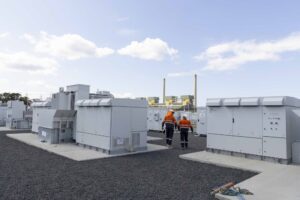Former prime minister and now aspiring pumped hydro project developer Malcolm Turnbull is calling for changes to the federal government’s Capacity Investment Scheme, arguing that long duration hydro needs a separate category with looser time constraints.
The CIS is Labor’s flagship policy to bring 32 gigawatts of new capacity into Australia’s main grid, including 9 GW and about 36 gigawatt hours (GWh) of storage. And it wants it all built by late 2029 to help meet its still ambitious target of 82 per cent renewables by 2030.
That timeline, however, is no good for pumped hydro project, which – like the Snowy 2.0 project Turnbull kicked off with great fanfare in 2019 – is running many years late, and at a multiple of original cost estimates.
Turnbull told the Energy Storage conference in Sydney on Wednesday that changes need to be made to the CIS – both in the deadline and the structure of the long duration storage tender.
See also: Capacity Investment Scheme: Why it must play the long duration storage game
“There should be separate tenders for short to medium storage, that’s to say less than eight hours, and long duration, more than than eight hours. Some people would argue long, really long duration should be 12 hours or more,” Turnbull said in a keynote address.
Turnbull also argued that long duration storage projects such as pumped hydro should benefit from a sort of up-front capacity payment, or contingency payments, that address the high up front costs and their critical role in dealing with wind and solar droughts, or dunkelflaute.
And he the contract term should be much longer than 15 years, given the long term nature of pumped hydro, which is designed to last 80 years or even a century.
Turnbull, or course, has skin in the game. The newly unveiled Turnbull Renewables is proposing a pumped hydro project in the Hunter Valley, and it will need some powerful incentives and/or support to reach financial close.
Both pumped hydro projects currently under construction in Australia – Snowy 2.0 and the smaller Kidston project in north Queensland – are almost entirely funded by governments, Snowy because it is owned by the government energy retailer and Kidston because it has secured funds through government agencies.
The Queensland government is also investing its own money for its planned Borumba and Pioneer pumped hydro projects, but Turnbull’s CIS design suggestions have support from other providers of long duration storage technologies.
Hydrostor, which has been contracted to build a 1600 MWh compressed air storage facility in an old zinc mine near Broken Hill, argues that the deadlines should be extended and a new category created for eight hour storage and more.
Hydrostor has won a contract with the NSW government for its Silver City battery through the state’s eight hour storage tender, but so too have three proposed eight-hour battery storage projects, and competing technologies fear they will have the rug pulled from beneath them by battery projects, which are both modular and quicker to build.
There are some differences, however, over how those rules should be applied. Should they be eight hour minimums, or 12 hours. Or should a multiplier, as solar thermal advocate Keith Lovegrove suggests, be the mechanism that prevents an arbitrary line through storage durations.
The CIS is now accepted as the country’s signature policy, but not everyone is entirely happy with the process. There are those, like Turnbull, who say long duration storage needs to be addressed to fill in the widening gaps as Australia moves on from its 82 per cent renewables target towards 90 per cent renewable share and more.
Some others argue that too many projects involved in the bidding for the five-month long tender processes get tied up in the process when only a minority will be winners.
They cite the 19 GW of capacity competing for just 600 MW of mandates in Victoria and South Australia. It will likely mean that prices are cheap, but many other projects will have few other options because the auction process is centrally controlled. A true market, they say, has disappeared.
Others complain about the design, noting that the floor price component will likely deliver little more comfort than a merchant-based project, and the price collar – beyond which project owners must share the added benefits with the governments – will mean they will have little incentive to play the market once that collar is reached.
Still, there is also a recognition that the government needed to do something to guarantee that capacity will be delivered, given all the other roadblocks including connection processes, planning approvals, labour costs and equipment supplies.
And it’s a different world to that proposed by the federal Coalition, which is determined to stop wind and solar and storage, and keep coal fired power plants open until such time as nuclear is available, which the CSIRO on Thursday confirmed will not be before the 2040s, and very costly.
Turnbull has said on repeated occasions that Coalition leader Peter Dutton’s obsessions with nuclear is “bonkers”, as it makes no economic sense, and no engineering sense since nuclear is not a technology that can “firm” renewables, as claimed by its advocates.
He related a story when, as prime minister, he had invited National MPs into his office to talk to them about nuclear, and go through the numbers. The audience included Barnaby Joyce, Keith Pitt, and George Christensen, and Bridget McKenzie.
After the meeting, Turnbull said, McKenzie stayed in his office and told him: “I wouldn’t bother them with numbers … it’s a religion.” And, that, Turnbull says, is the main problem.








